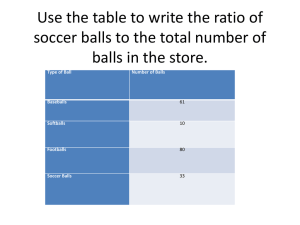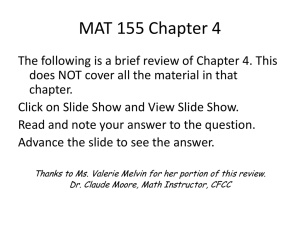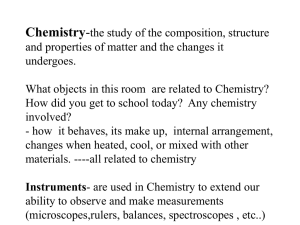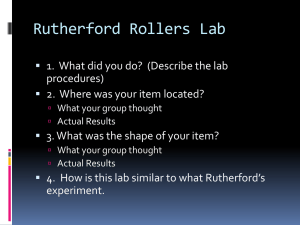1.2 PowerPoint
advertisement
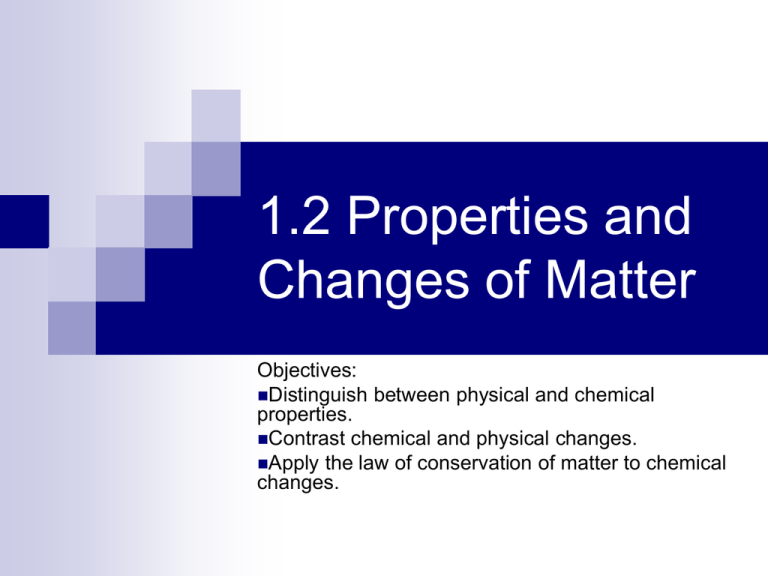
1.2 Properties and Changes of Matter Objectives: Distinguish between physical and chemical properties. Contrast chemical and physical changes. Apply the law of conservation of matter to chemical changes. Identifying Matter by Its Properties Physical properties are those that do not change the composition They can be quantitative or qualitative. Qualitative: The solid is hard. The liquid boils at a low temperature. Quantitative: Ice freezes at 0°C Iron has a density of 7.86 g/mL States of Matter Three common states of matter: Solid Liquid Gas Fourth less familiar type: Plasma: an ionized gas Solid Solid- a substance in which the particles occupy fixed positions in a well-defined, three-dimensional arrangement. Definite shape and volume. Examples: Iron Ice Liquid Liquid - a flowing substance with a definite volume but an indefinite shape. Definite volume and takes shape of container Examples: Water Mercury Bromine Gas Gas – a flowing, compressible substance with no definite shape or volume. Takes shape and volume of container Examples Oxygen Hydrogen Helium States of Matter The state in which matter is found depends on the temperature and pressure. When you discuss the physical state of matter you are discussing the state at room temperature (20-25°C) What is the physical state of neon at room temperature? States of Matter – Disc 2 States of Matter – Disc 2 Physical States the temperature at which matter changes from one state to another is closely related to its physical state Water freezes (and melts) at 0°C Salt melts (and freezes) at 804°C Oxygen freezes (and melts) at -218°C The melting points and freezing point are the same for substances Volatile Volatile – describes a substance that easily change to a gas at room temperature Alcohol and gasoline are more volatile then water. Naphthalene (mothballs) is a solid that is volatile. You can easily smell alcohol, gasoline and mothballs because since they are volatile the molecules are present in the air. Density Density- the amount of matter (mass) in a given unit volume. The units for density are usually g/mL Density You fill two beakers; one with cotton balls and one with marbles. The beaker with the marbles is heavier than the one with the cotton balls, but they both occupy the same volume (the beaker). The marbles have a larger mass than the cotton balls. Therefore, the marbles have a larger density than the cotton balls Densities of Some Common Materials Material Density, g/mL Water (4.0°C) 1.000 Ice (0°C) 0.917 Helium (25°C 0.000164 Air (25°C) 0.00119 Aluminum 2.70 Lead 11.34 Gold 19.31 Cork 0.22-0.26 Sugar 1.59 Balsa Wood 0.12 Determining Density One way you can determine density is by using water displacing 1. 2. 3. 4. 5. Weigh you object. (10 g) Fill a graduated cylinder with water to a particular mark. Such as, 10mL. Carefully add you object to the graduated cylinder. Record the level of the water. ( maybe 15mL) Next you use the weigh of you object and the level of the water to determine the density. a) Your water level started at 10mL and ended at 15mL. b) 15mL – 10mL = 5mL Next you take your mass and divide it by your volume. 10g/5mL = 2 g/mL Let’s Try It Determine the density of the objects provided by your teacher. The Composition of Pennies Read over this lab on page 38 & 39 of your packet. Make a flow chart of the procedure for this lab, using only pictures. We may use this technique for more complicated labs in the future. It’s a Liquid, It’s a Solid…It’s Slime Lab is on page 40 of your packet. You must wear safety glasses for this lab. Please, be very careful with the chemicals. You may work in groups of three. Chemical Properties and Changes Chemical Properties- can be observed only when there is a change in the composition of the substance. Describes the ability of a substance to react with another substance or to decompose Examples: Rusting Reactivity Hydrogen Peroxide (H2O2) Is always stored in brown bottles because it will break down to hydrogen and water gas when exposed to light. Chemical Change Chemical Change – the change of one or more substance into other substances. Also called a Chemical Reaction The sulfuric acid and the sugar If you add vinegar to baking soda Atoms and Chemical Change All matter is made up of atoms. Any chemical change involves the rearrangement of atoms. When water breaks down it is the rearrangement of the hydrogen and oxygen atoms. Oxygen molecules Hydrogen molecules Water molecules Law of Conservation of Mass Law of Conservation of Mass – in a chemical change, matter is neither created nor destroyed. Example: Water molecules 2 H2O O2 + 2H2 Law of Conservation of Mass Chemical Reactions and Energy Chemical changes involve some sort of energy change. Energy – the capacity to do work Many reactions give off energy and some absorb energy. – gives off heat Endothermic - absorbs heat Exothermic Chemistry and Chemical Reactions Are all around you and are in everything that you do. Properties Review 1. 2. 3. Distinguish between a liquid, solid, and a gas. Give an example of a physical change and a chemical change. What are two substances that would be considered volatile?

